BIZ201: Crystal Hotel Financial Performance and Ratio Analysis Report
VerifiedAdded on 2023/01/19
|12
|2508
|100
Report
AI Summary
This report provides a detailed financial analysis of Crystal Hotel, utilizing both ratio and vertical analysis techniques to evaluate its performance. The report examines the hotel's income statement, comparing it with industry benchmarks to assess revenue streams, cost of sales, and personnel costs. Profitability, efficiency, liquidity, and solvency ratios are calculated and interpreted to provide insights into the hotel's financial health. The analysis includes key performance indicators such as gross profit margin, net profit margin, return on assets, return on equity, inventory turnover, accounts receivable collection period, current ratio, quick ratio, debt-to-equity ratio, and other industry-specific metrics like average daily rate and revenue per available room. The report concludes with recommendations for improvement, focusing on areas such as cost reduction, staff management, and liquidity management to enhance Crystal Hotel's overall financial position and support its renovation plans.
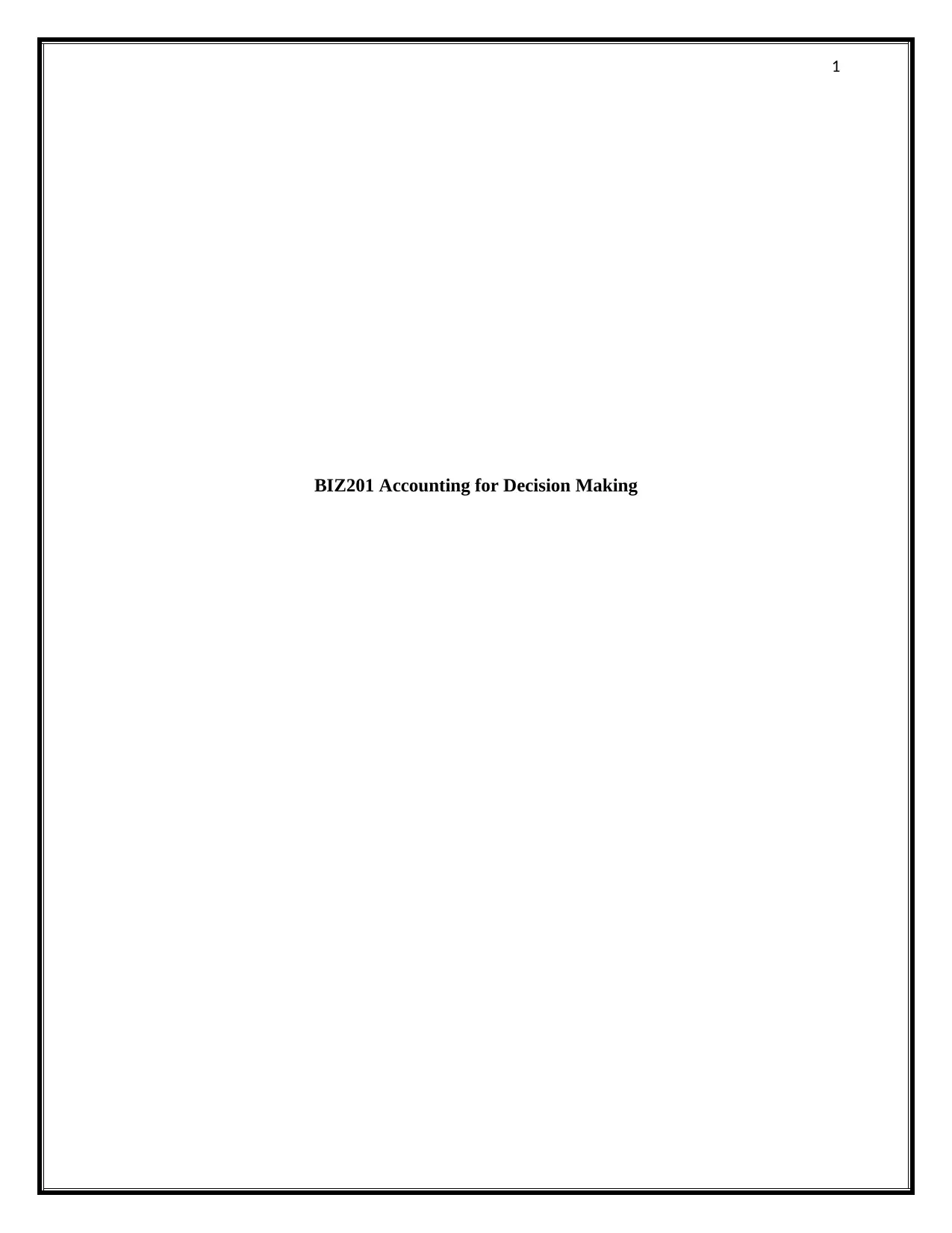
1
BIZ201 Accounting for Decision Making
BIZ201 Accounting for Decision Making
Paraphrase This Document
Need a fresh take? Get an instant paraphrase of this document with our AI Paraphraser
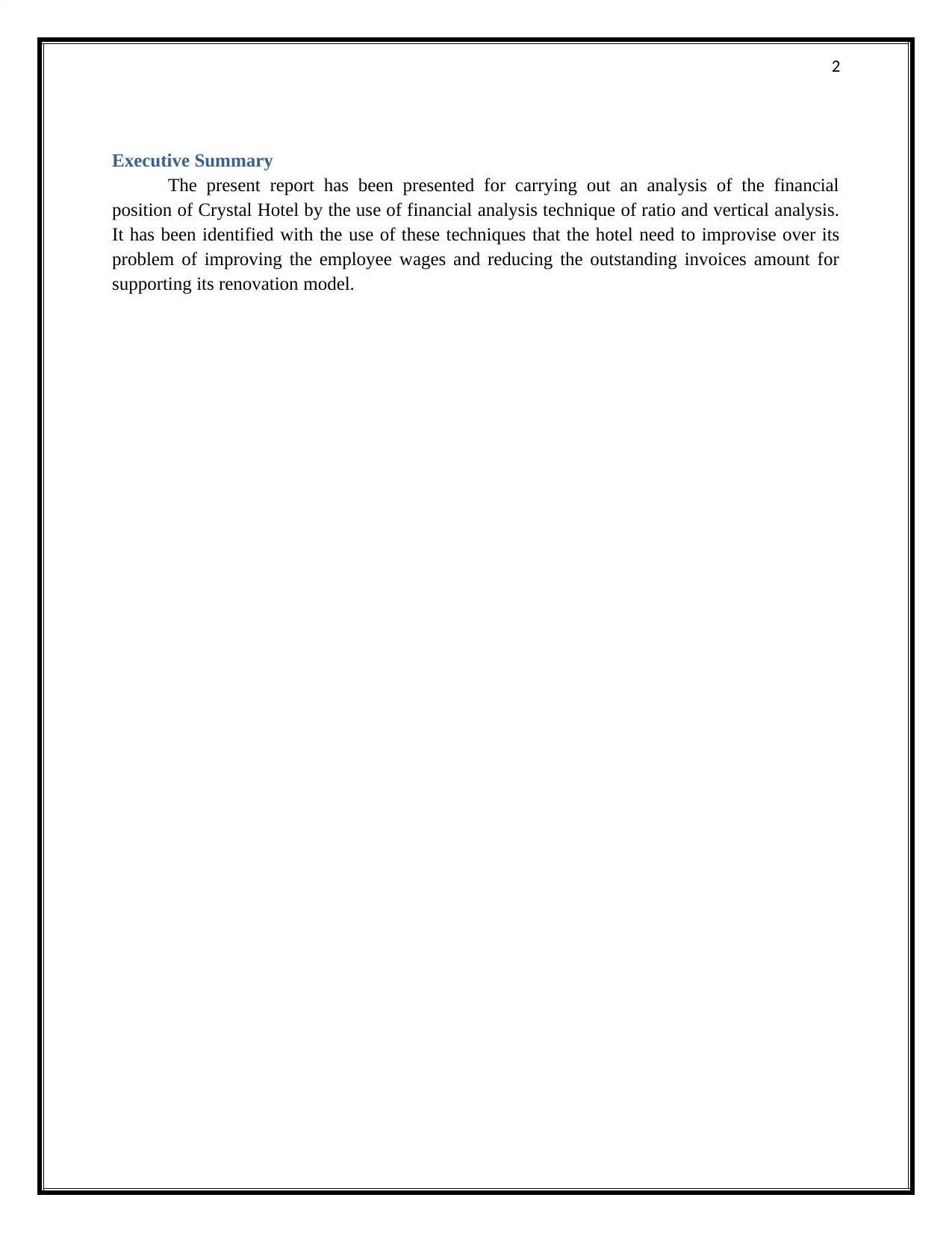
2
Executive Summary
The present report has been presented for carrying out an analysis of the financial
position of Crystal Hotel by the use of financial analysis technique of ratio and vertical analysis.
It has been identified with the use of these techniques that the hotel need to improvise over its
problem of improving the employee wages and reducing the outstanding invoices amount for
supporting its renovation model.
Executive Summary
The present report has been presented for carrying out an analysis of the financial
position of Crystal Hotel by the use of financial analysis technique of ratio and vertical analysis.
It has been identified with the use of these techniques that the hotel need to improvise over its
problem of improving the employee wages and reducing the outstanding invoices amount for
supporting its renovation model.
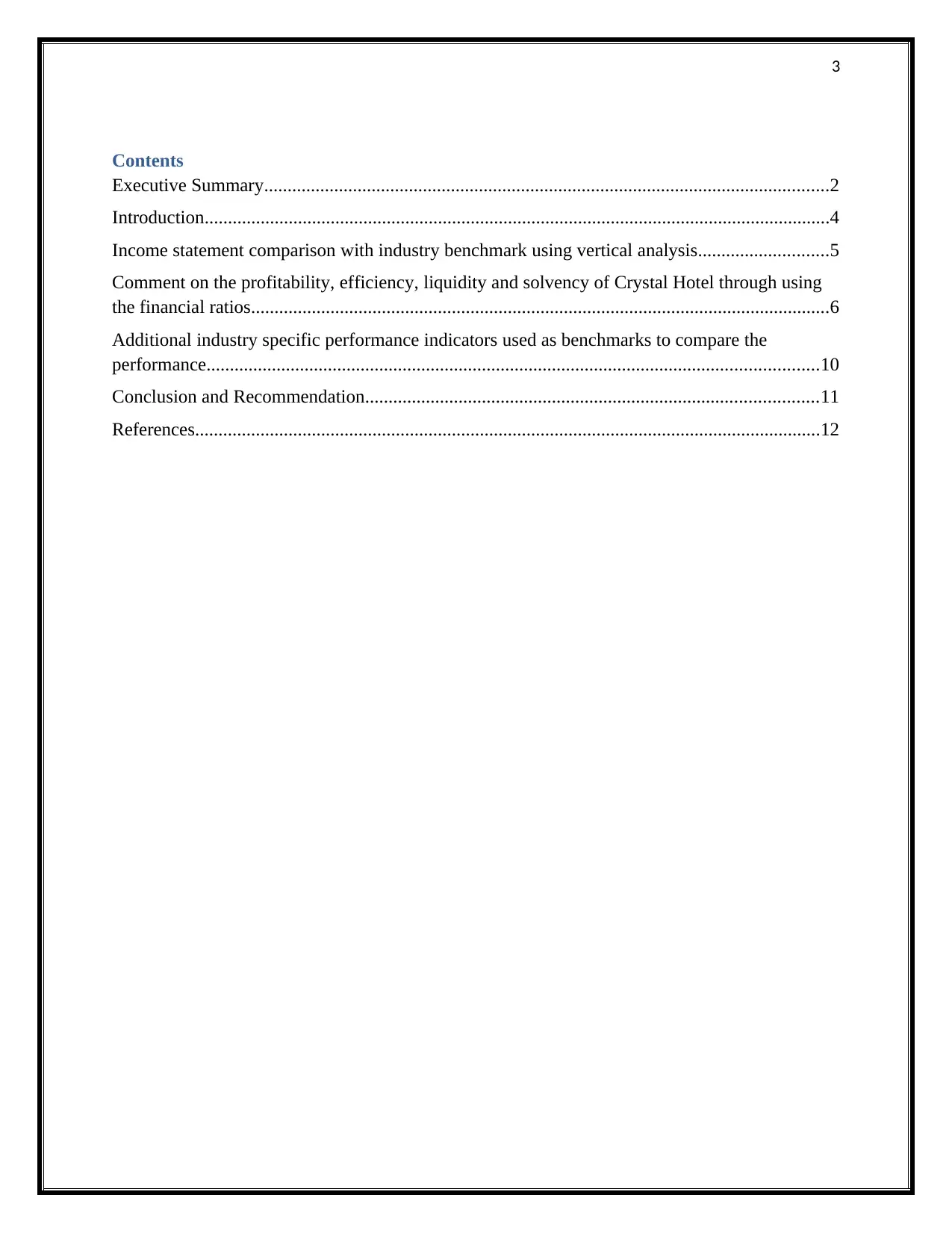
3
Contents
Executive Summary.........................................................................................................................2
Introduction......................................................................................................................................4
Income statement comparison with industry benchmark using vertical analysis............................5
Comment on the profitability, efficiency, liquidity and solvency of Crystal Hotel through using
the financial ratios............................................................................................................................6
Additional industry specific performance indicators used as benchmarks to compare the
performance...................................................................................................................................10
Conclusion and Recommendation.................................................................................................11
References......................................................................................................................................12
Contents
Executive Summary.........................................................................................................................2
Introduction......................................................................................................................................4
Income statement comparison with industry benchmark using vertical analysis............................5
Comment on the profitability, efficiency, liquidity and solvency of Crystal Hotel through using
the financial ratios............................................................................................................................6
Additional industry specific performance indicators used as benchmarks to compare the
performance...................................................................................................................................10
Conclusion and Recommendation.................................................................................................11
References......................................................................................................................................12
⊘ This is a preview!⊘
Do you want full access?
Subscribe today to unlock all pages.

Trusted by 1+ million students worldwide
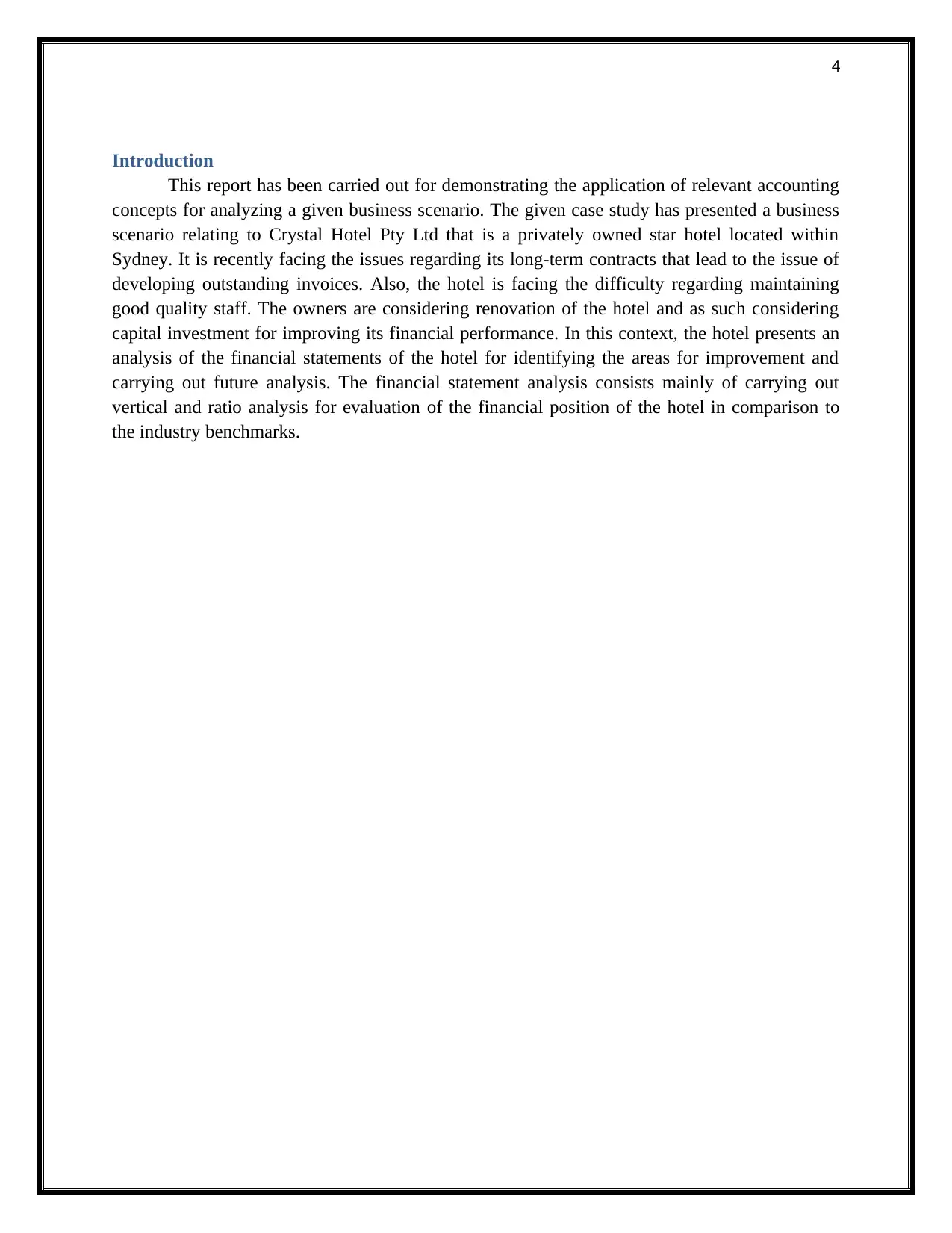
4
Introduction
This report has been carried out for demonstrating the application of relevant accounting
concepts for analyzing a given business scenario. The given case study has presented a business
scenario relating to Crystal Hotel Pty Ltd that is a privately owned star hotel located within
Sydney. It is recently facing the issues regarding its long-term contracts that lead to the issue of
developing outstanding invoices. Also, the hotel is facing the difficulty regarding maintaining
good quality staff. The owners are considering renovation of the hotel and as such considering
capital investment for improving its financial performance. In this context, the hotel presents an
analysis of the financial statements of the hotel for identifying the areas for improvement and
carrying out future analysis. The financial statement analysis consists mainly of carrying out
vertical and ratio analysis for evaluation of the financial position of the hotel in comparison to
the industry benchmarks.
Introduction
This report has been carried out for demonstrating the application of relevant accounting
concepts for analyzing a given business scenario. The given case study has presented a business
scenario relating to Crystal Hotel Pty Ltd that is a privately owned star hotel located within
Sydney. It is recently facing the issues regarding its long-term contracts that lead to the issue of
developing outstanding invoices. Also, the hotel is facing the difficulty regarding maintaining
good quality staff. The owners are considering renovation of the hotel and as such considering
capital investment for improving its financial performance. In this context, the hotel presents an
analysis of the financial statements of the hotel for identifying the areas for improvement and
carrying out future analysis. The financial statement analysis consists mainly of carrying out
vertical and ratio analysis for evaluation of the financial position of the hotel in comparison to
the industry benchmarks.
Paraphrase This Document
Need a fresh take? Get an instant paraphrase of this document with our AI Paraphraser
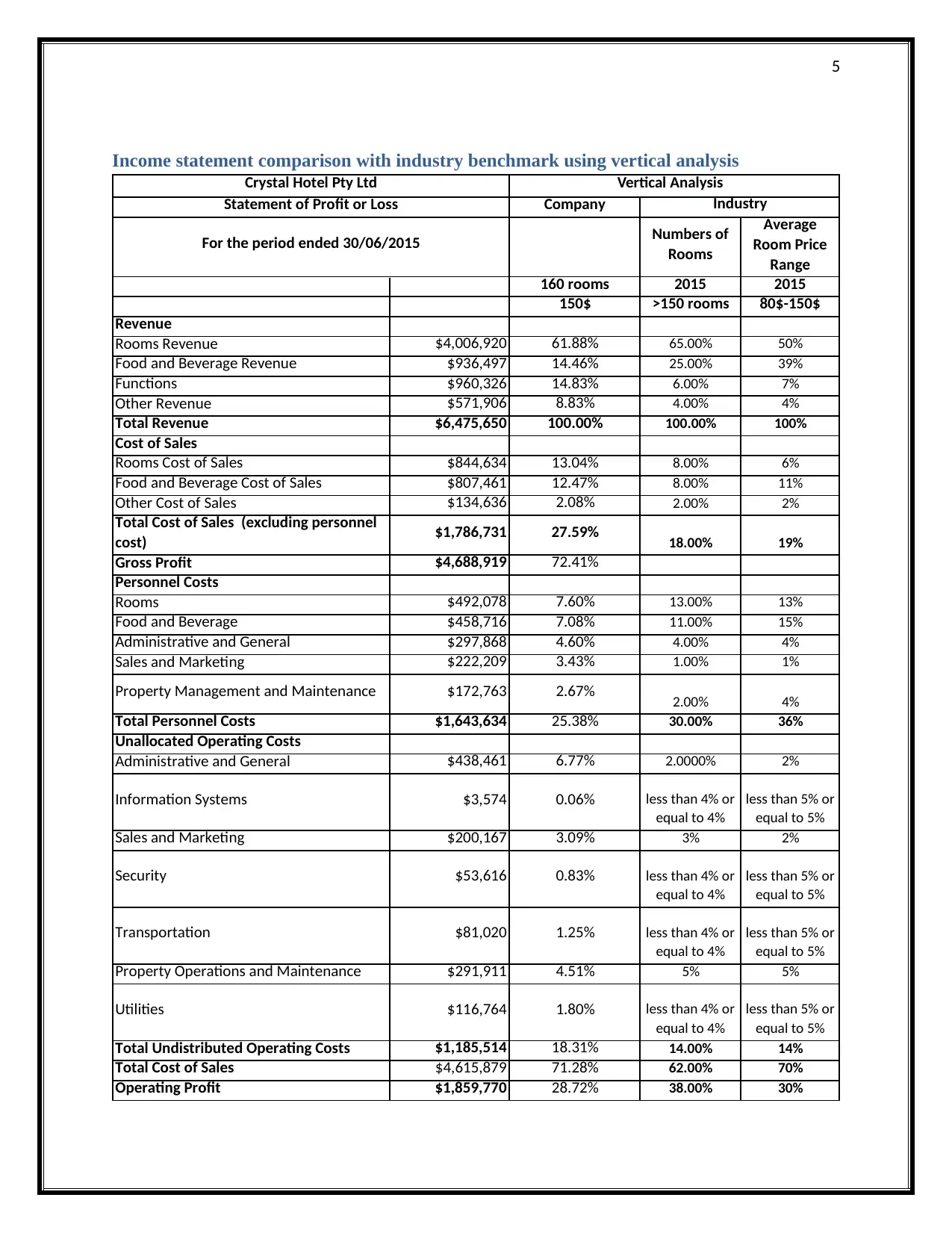
5
Income statement comparison with industry benchmark using vertical analysis
Company
Numbers of
Rooms
Average
Room Price
Range
160 rooms 2015 2015
150$ >150 rooms 80$-150$
Revenue
Rooms Revenue $4,006,920 61.88% 65.00% 50%
Food and Beverage Revenue $936,497 14.46% 25.00% 39%
Functions $960,326 14.83% 6.00% 7%
Other Revenue $571,906 8.83% 4.00% 4%
Total Revenue $6,475,650 100.00% 100.00% 100%
Cost of Sales
Rooms Cost of Sales $844,634 13.04% 8.00% 6%
Food and Beverage Cost of Sales $807,461 12.47% 8.00% 11%
Other Cost of Sales $134,636 2.08% 2.00% 2%
Total Cost of Sales (excluding personnel
cost) $1,786,731 27.59% 18.00% 19%
Gross Profit $4,688,919 72.41%
Personnel Costs
Rooms $492,078 7.60% 13.00% 13%
Food and Beverage $458,716 7.08% 11.00% 15%
Administrative and General $297,868 4.60% 4.00% 4%
Sales and Marketing $222,209 3.43% 1.00% 1%
Property Management and Maintenance $172,763 2.67% 2.00% 4%
Total Personnel Costs $1,643,634 25.38% 30.00% 36%
Unallocated Operating Costs
Administrative and General $438,461 6.77% 2.0000% 2%
Information Systems $3,574 0.06% less than 4% or
equal to 4%
less than 5% or
equal to 5%
Sales and Marketing $200,167 3.09% 3% 2%
Security $53,616 0.83% less than 4% or
equal to 4%
less than 5% or
equal to 5%
Transportation $81,020 1.25% less than 4% or
equal to 4%
less than 5% or
equal to 5%
Property Operations and Maintenance $291,911 4.51% 5% 5%
Utilities $116,764 1.80% less than 4% or
equal to 4%
less than 5% or
equal to 5%
Total Undistributed Operating Costs $1,185,514 18.31% 14.00% 14%
Total Cost of Sales $4,615,879 71.28% 62.00% 70%
Operating Profit $1,859,770 28.72% 38.00% 30%
Crystal Hotel Pty Ltd
Statement of Profit or Loss
For the period ended 30/06/2015
Vertical Analysis
Industry
Income statement comparison with industry benchmark using vertical analysis
Company
Numbers of
Rooms
Average
Room Price
Range
160 rooms 2015 2015
150$ >150 rooms 80$-150$
Revenue
Rooms Revenue $4,006,920 61.88% 65.00% 50%
Food and Beverage Revenue $936,497 14.46% 25.00% 39%
Functions $960,326 14.83% 6.00% 7%
Other Revenue $571,906 8.83% 4.00% 4%
Total Revenue $6,475,650 100.00% 100.00% 100%
Cost of Sales
Rooms Cost of Sales $844,634 13.04% 8.00% 6%
Food and Beverage Cost of Sales $807,461 12.47% 8.00% 11%
Other Cost of Sales $134,636 2.08% 2.00% 2%
Total Cost of Sales (excluding personnel
cost) $1,786,731 27.59% 18.00% 19%
Gross Profit $4,688,919 72.41%
Personnel Costs
Rooms $492,078 7.60% 13.00% 13%
Food and Beverage $458,716 7.08% 11.00% 15%
Administrative and General $297,868 4.60% 4.00% 4%
Sales and Marketing $222,209 3.43% 1.00% 1%
Property Management and Maintenance $172,763 2.67% 2.00% 4%
Total Personnel Costs $1,643,634 25.38% 30.00% 36%
Unallocated Operating Costs
Administrative and General $438,461 6.77% 2.0000% 2%
Information Systems $3,574 0.06% less than 4% or
equal to 4%
less than 5% or
equal to 5%
Sales and Marketing $200,167 3.09% 3% 2%
Security $53,616 0.83% less than 4% or
equal to 4%
less than 5% or
equal to 5%
Transportation $81,020 1.25% less than 4% or
equal to 4%
less than 5% or
equal to 5%
Property Operations and Maintenance $291,911 4.51% 5% 5%
Utilities $116,764 1.80% less than 4% or
equal to 4%
less than 5% or
equal to 5%
Total Undistributed Operating Costs $1,185,514 18.31% 14.00% 14%
Total Cost of Sales $4,615,879 71.28% 62.00% 70%
Operating Profit $1,859,770 28.72% 38.00% 30%
Crystal Hotel Pty Ltd
Statement of Profit or Loss
For the period ended 30/06/2015
Vertical Analysis
Industry
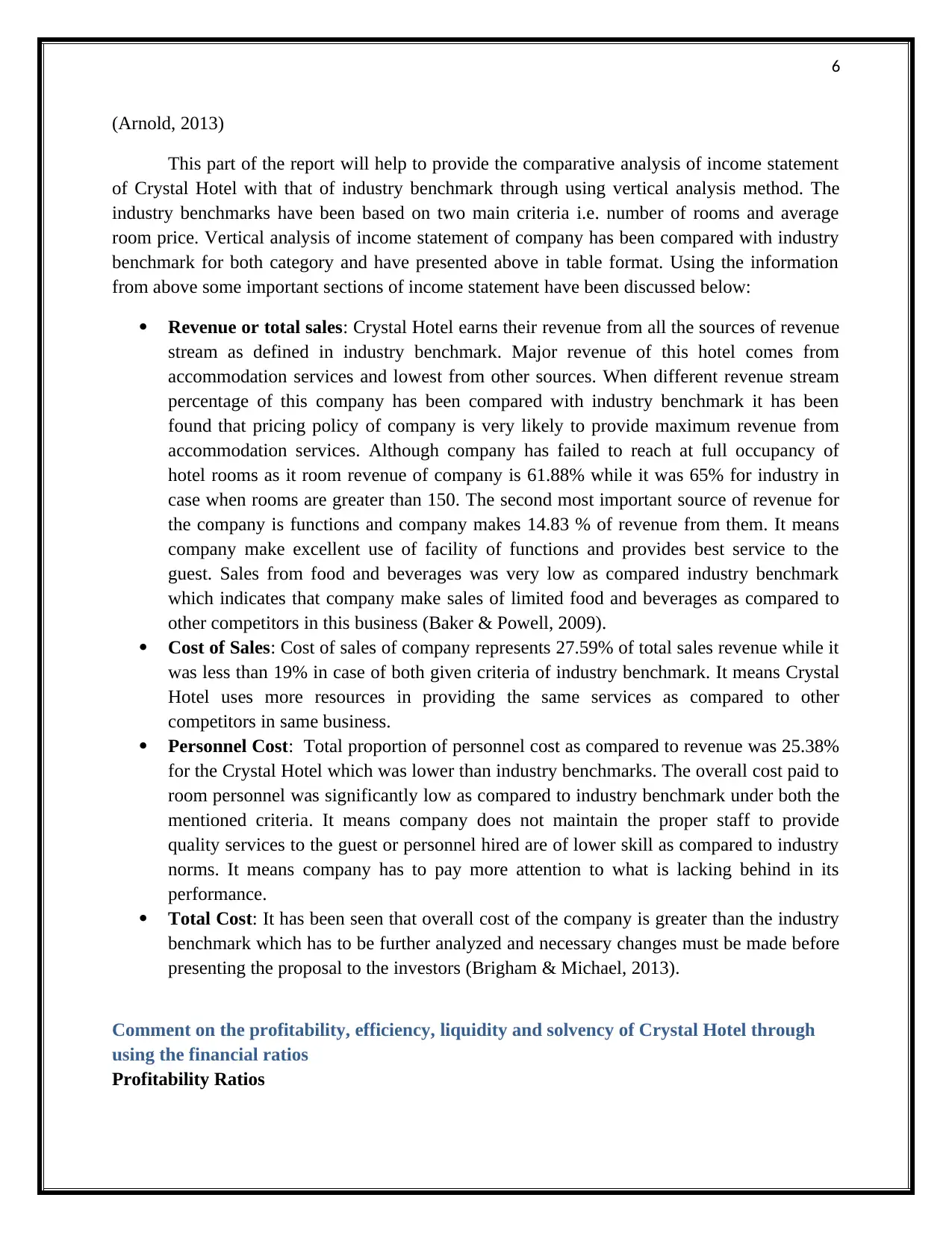
6
(Arnold, 2013)
This part of the report will help to provide the comparative analysis of income statement
of Crystal Hotel with that of industry benchmark through using vertical analysis method. The
industry benchmarks have been based on two main criteria i.e. number of rooms and average
room price. Vertical analysis of income statement of company has been compared with industry
benchmark for both category and have presented above in table format. Using the information
from above some important sections of income statement have been discussed below:
Revenue or total sales: Crystal Hotel earns their revenue from all the sources of revenue
stream as defined in industry benchmark. Major revenue of this hotel comes from
accommodation services and lowest from other sources. When different revenue stream
percentage of this company has been compared with industry benchmark it has been
found that pricing policy of company is very likely to provide maximum revenue from
accommodation services. Although company has failed to reach at full occupancy of
hotel rooms as it room revenue of company is 61.88% while it was 65% for industry in
case when rooms are greater than 150. The second most important source of revenue for
the company is functions and company makes 14.83 % of revenue from them. It means
company make excellent use of facility of functions and provides best service to the
guest. Sales from food and beverages was very low as compared industry benchmark
which indicates that company make sales of limited food and beverages as compared to
other competitors in this business (Baker & Powell, 2009).
Cost of Sales: Cost of sales of company represents 27.59% of total sales revenue while it
was less than 19% in case of both given criteria of industry benchmark. It means Crystal
Hotel uses more resources in providing the same services as compared to other
competitors in same business.
Personnel Cost: Total proportion of personnel cost as compared to revenue was 25.38%
for the Crystal Hotel which was lower than industry benchmarks. The overall cost paid to
room personnel was significantly low as compared to industry benchmark under both the
mentioned criteria. It means company does not maintain the proper staff to provide
quality services to the guest or personnel hired are of lower skill as compared to industry
norms. It means company has to pay more attention to what is lacking behind in its
performance.
Total Cost: It has been seen that overall cost of the company is greater than the industry
benchmark which has to be further analyzed and necessary changes must be made before
presenting the proposal to the investors (Brigham & Michael, 2013).
Comment on the profitability, efficiency, liquidity and solvency of Crystal Hotel through
using the financial ratios
Profitability Ratios
(Arnold, 2013)
This part of the report will help to provide the comparative analysis of income statement
of Crystal Hotel with that of industry benchmark through using vertical analysis method. The
industry benchmarks have been based on two main criteria i.e. number of rooms and average
room price. Vertical analysis of income statement of company has been compared with industry
benchmark for both category and have presented above in table format. Using the information
from above some important sections of income statement have been discussed below:
Revenue or total sales: Crystal Hotel earns their revenue from all the sources of revenue
stream as defined in industry benchmark. Major revenue of this hotel comes from
accommodation services and lowest from other sources. When different revenue stream
percentage of this company has been compared with industry benchmark it has been
found that pricing policy of company is very likely to provide maximum revenue from
accommodation services. Although company has failed to reach at full occupancy of
hotel rooms as it room revenue of company is 61.88% while it was 65% for industry in
case when rooms are greater than 150. The second most important source of revenue for
the company is functions and company makes 14.83 % of revenue from them. It means
company make excellent use of facility of functions and provides best service to the
guest. Sales from food and beverages was very low as compared industry benchmark
which indicates that company make sales of limited food and beverages as compared to
other competitors in this business (Baker & Powell, 2009).
Cost of Sales: Cost of sales of company represents 27.59% of total sales revenue while it
was less than 19% in case of both given criteria of industry benchmark. It means Crystal
Hotel uses more resources in providing the same services as compared to other
competitors in same business.
Personnel Cost: Total proportion of personnel cost as compared to revenue was 25.38%
for the Crystal Hotel which was lower than industry benchmarks. The overall cost paid to
room personnel was significantly low as compared to industry benchmark under both the
mentioned criteria. It means company does not maintain the proper staff to provide
quality services to the guest or personnel hired are of lower skill as compared to industry
norms. It means company has to pay more attention to what is lacking behind in its
performance.
Total Cost: It has been seen that overall cost of the company is greater than the industry
benchmark which has to be further analyzed and necessary changes must be made before
presenting the proposal to the investors (Brigham & Michael, 2013).
Comment on the profitability, efficiency, liquidity and solvency of Crystal Hotel through
using the financial ratios
Profitability Ratios
⊘ This is a preview!⊘
Do you want full access?
Subscribe today to unlock all pages.

Trusted by 1+ million students worldwide
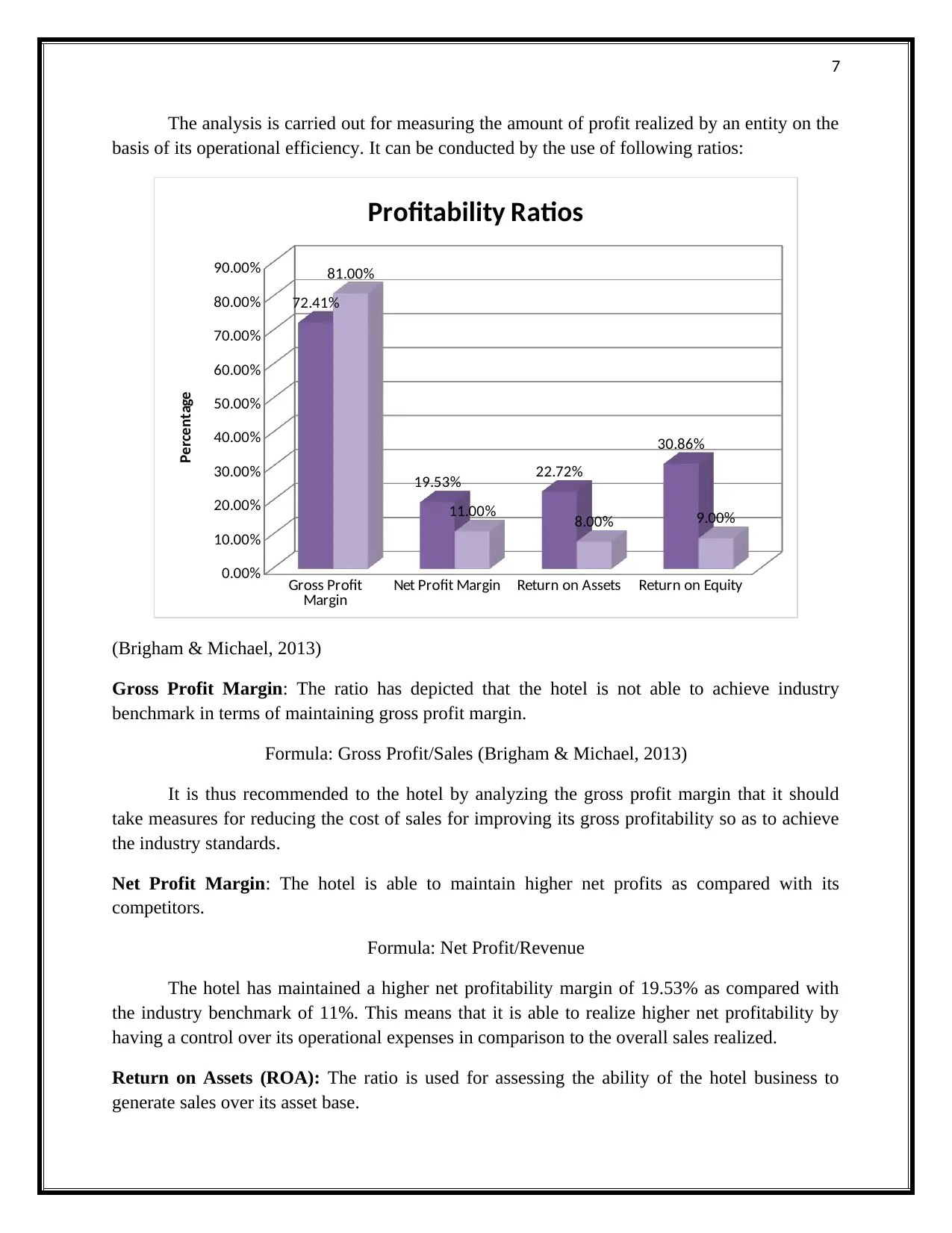
7
The analysis is carried out for measuring the amount of profit realized by an entity on the
basis of its operational efficiency. It can be conducted by the use of following ratios:
Gross Profit
Margin Net Profit Margin Return on Assets Return on Equity
0.00%
10.00%
20.00%
30.00%
40.00%
50.00%
60.00%
70.00%
80.00%
90.00%
72.41%
19.53% 22.72%
30.86%
81.00%
11.00% 8.00% 9.00%
Profitability Ratios
Percentage
(Brigham & Michael, 2013)
Gross Profit Margin: The ratio has depicted that the hotel is not able to achieve industry
benchmark in terms of maintaining gross profit margin.
Formula: Gross Profit/Sales (Brigham & Michael, 2013)
It is thus recommended to the hotel by analyzing the gross profit margin that it should
take measures for reducing the cost of sales for improving its gross profitability so as to achieve
the industry standards.
Net Profit Margin: The hotel is able to maintain higher net profits as compared with its
competitors.
Formula: Net Profit/Revenue
The hotel has maintained a higher net profitability margin of 19.53% as compared with
the industry benchmark of 11%. This means that it is able to realize higher net profitability by
having a control over its operational expenses in comparison to the overall sales realized.
Return on Assets (ROA): The ratio is used for assessing the ability of the hotel business to
generate sales over its asset base.
The analysis is carried out for measuring the amount of profit realized by an entity on the
basis of its operational efficiency. It can be conducted by the use of following ratios:
Gross Profit
Margin Net Profit Margin Return on Assets Return on Equity
0.00%
10.00%
20.00%
30.00%
40.00%
50.00%
60.00%
70.00%
80.00%
90.00%
72.41%
19.53% 22.72%
30.86%
81.00%
11.00% 8.00% 9.00%
Profitability Ratios
Percentage
(Brigham & Michael, 2013)
Gross Profit Margin: The ratio has depicted that the hotel is not able to achieve industry
benchmark in terms of maintaining gross profit margin.
Formula: Gross Profit/Sales (Brigham & Michael, 2013)
It is thus recommended to the hotel by analyzing the gross profit margin that it should
take measures for reducing the cost of sales for improving its gross profitability so as to achieve
the industry standards.
Net Profit Margin: The hotel is able to maintain higher net profits as compared with its
competitors.
Formula: Net Profit/Revenue
The hotel has maintained a higher net profitability margin of 19.53% as compared with
the industry benchmark of 11%. This means that it is able to realize higher net profitability by
having a control over its operational expenses in comparison to the overall sales realized.
Return on Assets (ROA): The ratio is used for assessing the ability of the hotel business to
generate sales over its asset base.
Paraphrase This Document
Need a fresh take? Get an instant paraphrase of this document with our AI Paraphraser
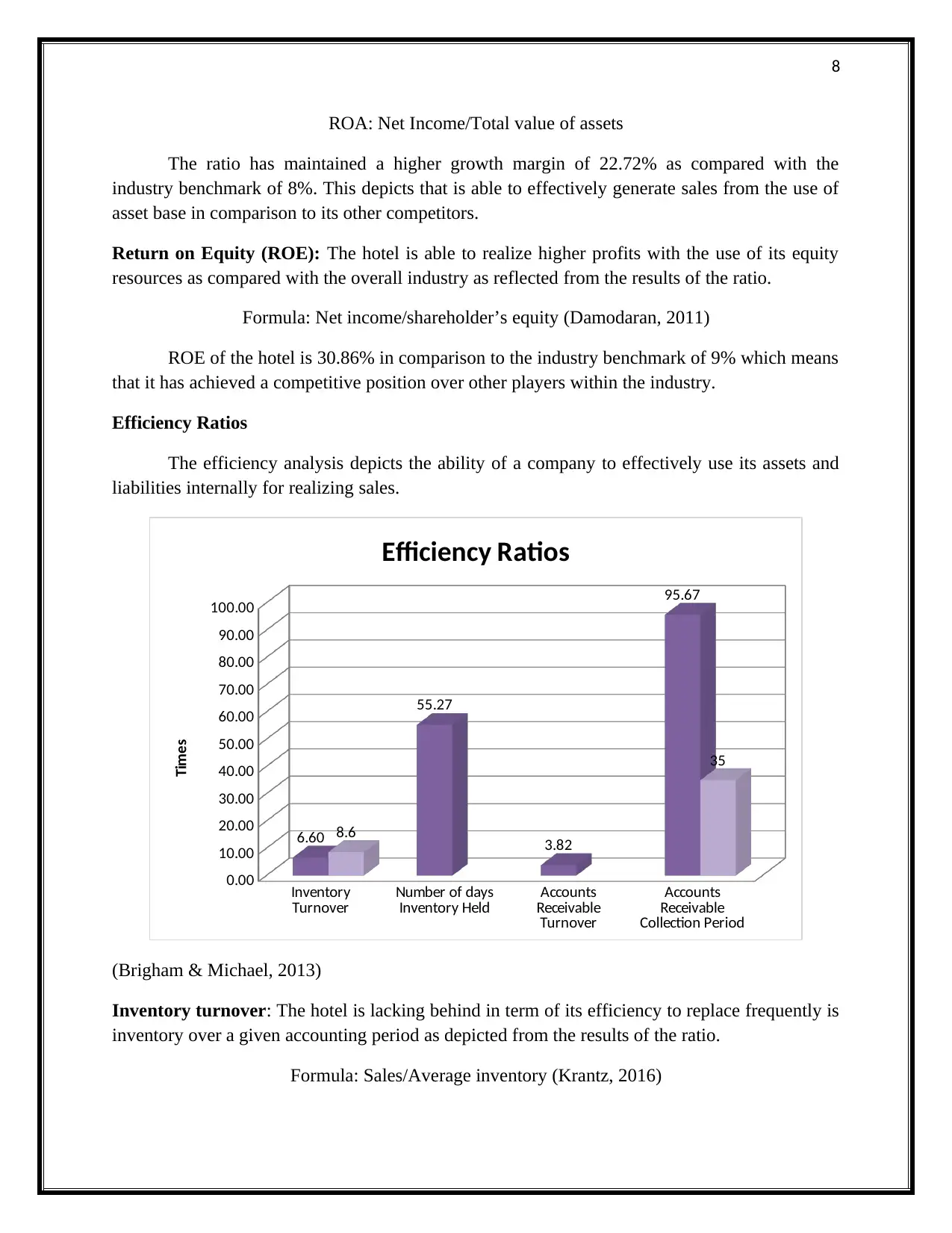
8
ROA: Net Income/Total value of assets
The ratio has maintained a higher growth margin of 22.72% as compared with the
industry benchmark of 8%. This depicts that is able to effectively generate sales from the use of
asset base in comparison to its other competitors.
Return on Equity (ROE): The hotel is able to realize higher profits with the use of its equity
resources as compared with the overall industry as reflected from the results of the ratio.
Formula: Net income/shareholder’s equity (Damodaran, 2011)
ROE of the hotel is 30.86% in comparison to the industry benchmark of 9% which means
that it has achieved a competitive position over other players within the industry.
Efficiency Ratios
The efficiency analysis depicts the ability of a company to effectively use its assets and
liabilities internally for realizing sales.
Inventory
Turnover Number of days
Inventory Held Accounts
Receivable
Turnover
Accounts
Receivable
Collection Period
0.00
10.00
20.00
30.00
40.00
50.00
60.00
70.00
80.00
90.00
100.00
6.60
55.27
3.82
95.67
8.6
35
Efficiency Ratios
Times
(Brigham & Michael, 2013)
Inventory turnover: The hotel is lacking behind in term of its efficiency to replace frequently is
inventory over a given accounting period as depicted from the results of the ratio.
Formula: Sales/Average inventory (Krantz, 2016)
ROA: Net Income/Total value of assets
The ratio has maintained a higher growth margin of 22.72% as compared with the
industry benchmark of 8%. This depicts that is able to effectively generate sales from the use of
asset base in comparison to its other competitors.
Return on Equity (ROE): The hotel is able to realize higher profits with the use of its equity
resources as compared with the overall industry as reflected from the results of the ratio.
Formula: Net income/shareholder’s equity (Damodaran, 2011)
ROE of the hotel is 30.86% in comparison to the industry benchmark of 9% which means
that it has achieved a competitive position over other players within the industry.
Efficiency Ratios
The efficiency analysis depicts the ability of a company to effectively use its assets and
liabilities internally for realizing sales.
Inventory
Turnover Number of days
Inventory Held Accounts
Receivable
Turnover
Accounts
Receivable
Collection Period
0.00
10.00
20.00
30.00
40.00
50.00
60.00
70.00
80.00
90.00
100.00
6.60
55.27
3.82
95.67
8.6
35
Efficiency Ratios
Times
(Brigham & Michael, 2013)
Inventory turnover: The hotel is lacking behind in term of its efficiency to replace frequently is
inventory over a given accounting period as depicted from the results of the ratio.
Formula: Sales/Average inventory (Krantz, 2016)
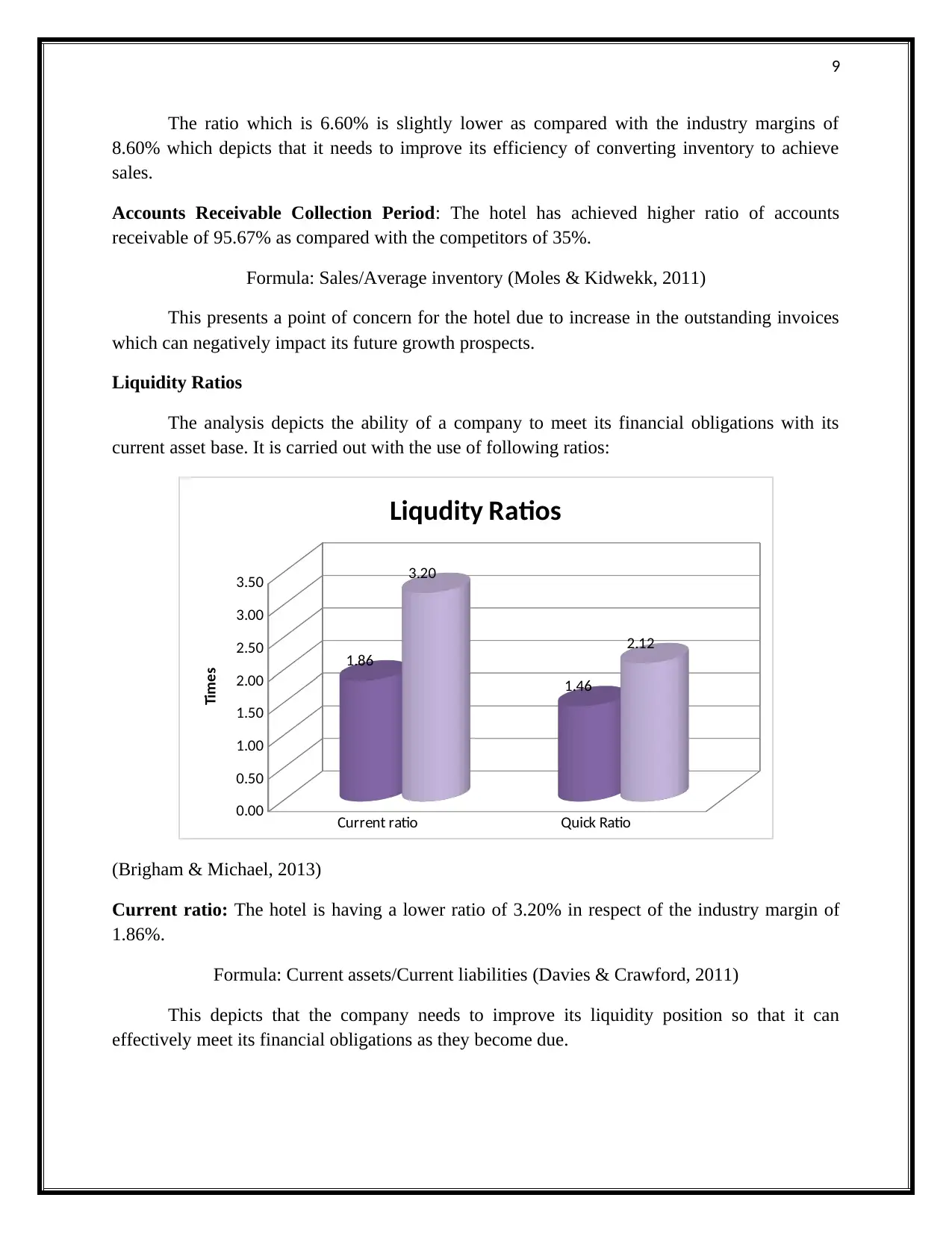
9
The ratio which is 6.60% is slightly lower as compared with the industry margins of
8.60% which depicts that it needs to improve its efficiency of converting inventory to achieve
sales.
Accounts Receivable Collection Period: The hotel has achieved higher ratio of accounts
receivable of 95.67% as compared with the competitors of 35%.
Formula: Sales/Average inventory (Moles & Kidwekk, 2011)
This presents a point of concern for the hotel due to increase in the outstanding invoices
which can negatively impact its future growth prospects.
Liquidity Ratios
The analysis depicts the ability of a company to meet its financial obligations with its
current asset base. It is carried out with the use of following ratios:
Current ratio Quick Ratio
0.00
0.50
1.00
1.50
2.00
2.50
3.00
3.50
1.86
1.46
3.20
2.12
Liqudity Ratios
Times
(Brigham & Michael, 2013)
Current ratio: The hotel is having a lower ratio of 3.20% in respect of the industry margin of
1.86%.
Formula: Current assets/Current liabilities (Davies & Crawford, 2011)
This depicts that the company needs to improve its liquidity position so that it can
effectively meet its financial obligations as they become due.
The ratio which is 6.60% is slightly lower as compared with the industry margins of
8.60% which depicts that it needs to improve its efficiency of converting inventory to achieve
sales.
Accounts Receivable Collection Period: The hotel has achieved higher ratio of accounts
receivable of 95.67% as compared with the competitors of 35%.
Formula: Sales/Average inventory (Moles & Kidwekk, 2011)
This presents a point of concern for the hotel due to increase in the outstanding invoices
which can negatively impact its future growth prospects.
Liquidity Ratios
The analysis depicts the ability of a company to meet its financial obligations with its
current asset base. It is carried out with the use of following ratios:
Current ratio Quick Ratio
0.00
0.50
1.00
1.50
2.00
2.50
3.00
3.50
1.86
1.46
3.20
2.12
Liqudity Ratios
Times
(Brigham & Michael, 2013)
Current ratio: The hotel is having a lower ratio of 3.20% in respect of the industry margin of
1.86%.
Formula: Current assets/Current liabilities (Davies & Crawford, 2011)
This depicts that the company needs to improve its liquidity position so that it can
effectively meet its financial obligations as they become due.
⊘ This is a preview!⊘
Do you want full access?
Subscribe today to unlock all pages.

Trusted by 1+ million students worldwide
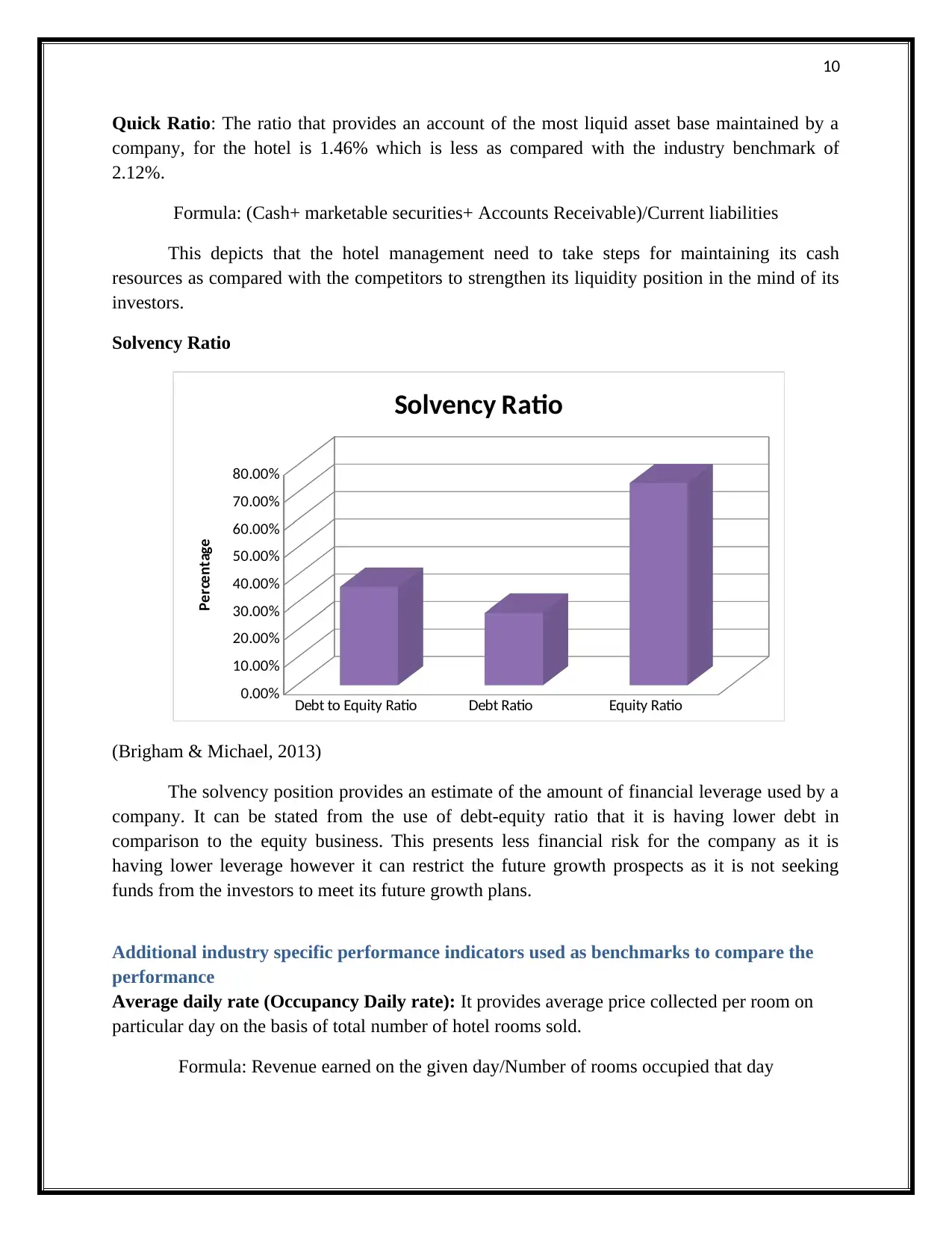
10
Quick Ratio: The ratio that provides an account of the most liquid asset base maintained by a
company, for the hotel is 1.46% which is less as compared with the industry benchmark of
2.12%.
Formula: (Cash+ marketable securities+ Accounts Receivable)/Current liabilities
This depicts that the hotel management need to take steps for maintaining its cash
resources as compared with the competitors to strengthen its liquidity position in the mind of its
investors.
Solvency Ratio
Debt to Equity Ratio Debt Ratio Equity Ratio
0.00%
10.00%
20.00%
30.00%
40.00%
50.00%
60.00%
70.00%
80.00%
Solvency Ratio
Percentage
(Brigham & Michael, 2013)
The solvency position provides an estimate of the amount of financial leverage used by a
company. It can be stated from the use of debt-equity ratio that it is having lower debt in
comparison to the equity business. This presents less financial risk for the company as it is
having lower leverage however it can restrict the future growth prospects as it is not seeking
funds from the investors to meet its future growth plans.
Additional industry specific performance indicators used as benchmarks to compare the
performance
Average daily rate (Occupancy Daily rate): It provides average price collected per room on
particular day on the basis of total number of hotel rooms sold.
Formula: Revenue earned on the given day/Number of rooms occupied that day
Quick Ratio: The ratio that provides an account of the most liquid asset base maintained by a
company, for the hotel is 1.46% which is less as compared with the industry benchmark of
2.12%.
Formula: (Cash+ marketable securities+ Accounts Receivable)/Current liabilities
This depicts that the hotel management need to take steps for maintaining its cash
resources as compared with the competitors to strengthen its liquidity position in the mind of its
investors.
Solvency Ratio
Debt to Equity Ratio Debt Ratio Equity Ratio
0.00%
10.00%
20.00%
30.00%
40.00%
50.00%
60.00%
70.00%
80.00%
Solvency Ratio
Percentage
(Brigham & Michael, 2013)
The solvency position provides an estimate of the amount of financial leverage used by a
company. It can be stated from the use of debt-equity ratio that it is having lower debt in
comparison to the equity business. This presents less financial risk for the company as it is
having lower leverage however it can restrict the future growth prospects as it is not seeking
funds from the investors to meet its future growth plans.
Additional industry specific performance indicators used as benchmarks to compare the
performance
Average daily rate (Occupancy Daily rate): It provides average price collected per room on
particular day on the basis of total number of hotel rooms sold.
Formula: Revenue earned on the given day/Number of rooms occupied that day
Paraphrase This Document
Need a fresh take? Get an instant paraphrase of this document with our AI Paraphraser

11
Revenue per available room REVPAR: This performance ratio measures the revenue earned
on average basis on the given number of rooms.
Formula: Total Room Revenue/Rooms available
Occupancy %: It provides total number of rooms occupied as compared to rooms available
Formula: Rooms Occupied/Rooms Available (Zimmerman & Yahya-Zadeh, 2011)
Conclusion and Recommendation
It can be stated from analyzing the financial performance of Crystal Hotel with the use of
vertical and ratio analysis technique that it need to improve in certain areas for achieving the
industry margin. The vertical analysis has depicted that it need to focus on reducing its overall
expenses and place emphasis on improving the personnel cost as compared with the competitors
for reducing the problem of staff turnover. Also, it needs to improve on its ability to maintain
current asset base for meeting the financial obligations. The hotel business also needs to improve
the account receivable turnover position for reducing its outstanding invoices amount and
realizing the amount of its credit sales appropriately.
Revenue per available room REVPAR: This performance ratio measures the revenue earned
on average basis on the given number of rooms.
Formula: Total Room Revenue/Rooms available
Occupancy %: It provides total number of rooms occupied as compared to rooms available
Formula: Rooms Occupied/Rooms Available (Zimmerman & Yahya-Zadeh, 2011)
Conclusion and Recommendation
It can be stated from analyzing the financial performance of Crystal Hotel with the use of
vertical and ratio analysis technique that it need to improve in certain areas for achieving the
industry margin. The vertical analysis has depicted that it need to focus on reducing its overall
expenses and place emphasis on improving the personnel cost as compared with the competitors
for reducing the problem of staff turnover. Also, it needs to improve on its ability to maintain
current asset base for meeting the financial obligations. The hotel business also needs to improve
the account receivable turnover position for reducing its outstanding invoices amount and
realizing the amount of its credit sales appropriately.
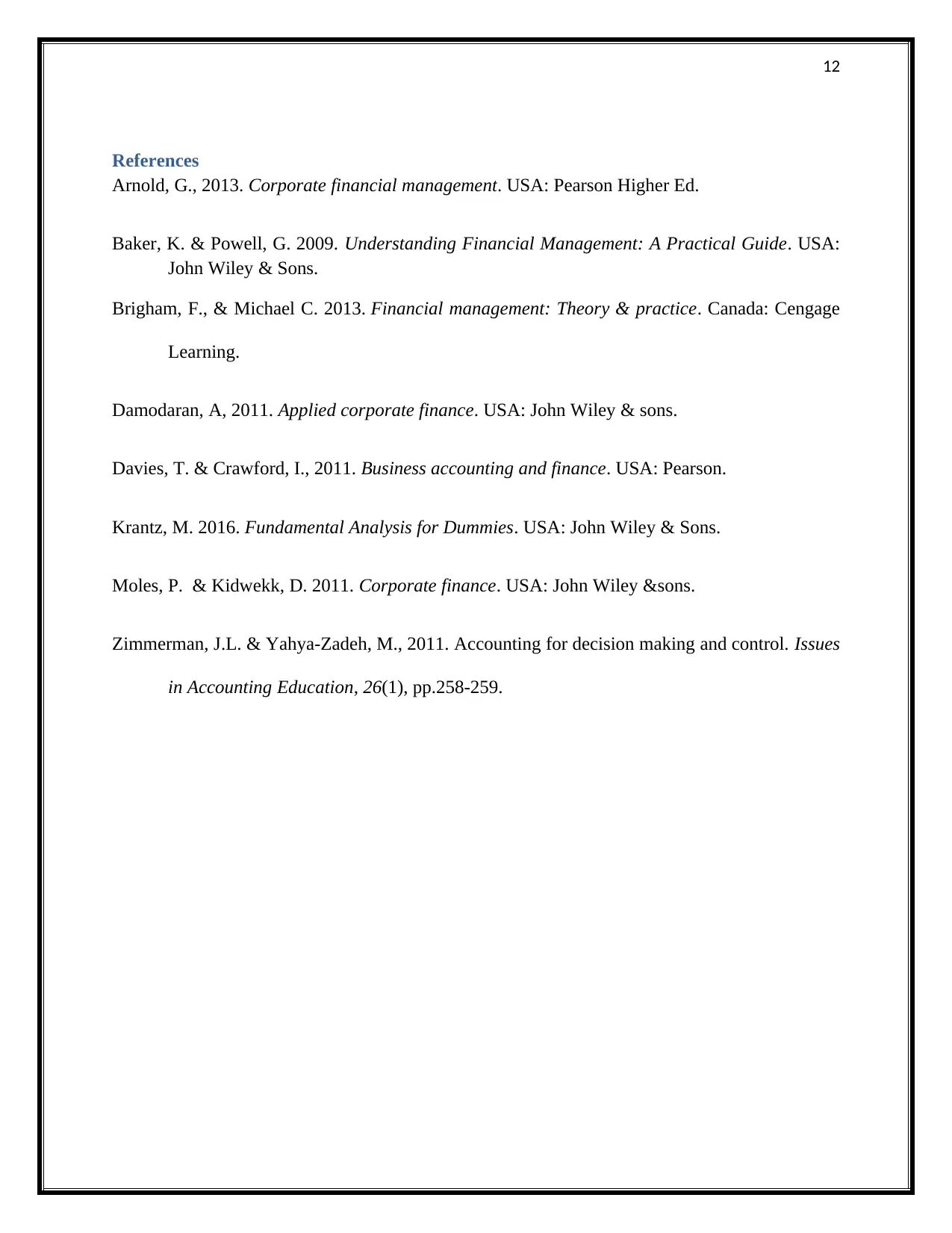
12
References
Arnold, G., 2013. Corporate financial management. USA: Pearson Higher Ed.
Baker, K. & Powell, G. 2009. Understanding Financial Management: A Practical Guide. USA:
John Wiley & Sons.
Brigham, F., & Michael C. 2013. Financial management: Theory & practice. Canada: Cengage
Learning.
Damodaran, A, 2011. Applied corporate finance. USA: John Wiley & sons.
Davies, T. & Crawford, I., 2011. Business accounting and finance. USA: Pearson.
Krantz, M. 2016. Fundamental Analysis for Dummies. USA: John Wiley & Sons.
Moles, P. & Kidwekk, D. 2011. Corporate finance. USA: John Wiley &sons.
Zimmerman, J.L. & Yahya-Zadeh, M., 2011. Accounting for decision making and control. Issues
in Accounting Education, 26(1), pp.258-259.
References
Arnold, G., 2013. Corporate financial management. USA: Pearson Higher Ed.
Baker, K. & Powell, G. 2009. Understanding Financial Management: A Practical Guide. USA:
John Wiley & Sons.
Brigham, F., & Michael C. 2013. Financial management: Theory & practice. Canada: Cengage
Learning.
Damodaran, A, 2011. Applied corporate finance. USA: John Wiley & sons.
Davies, T. & Crawford, I., 2011. Business accounting and finance. USA: Pearson.
Krantz, M. 2016. Fundamental Analysis for Dummies. USA: John Wiley & Sons.
Moles, P. & Kidwekk, D. 2011. Corporate finance. USA: John Wiley &sons.
Zimmerman, J.L. & Yahya-Zadeh, M., 2011. Accounting for decision making and control. Issues
in Accounting Education, 26(1), pp.258-259.
⊘ This is a preview!⊘
Do you want full access?
Subscribe today to unlock all pages.

Trusted by 1+ million students worldwide
1 out of 12
Related Documents
Your All-in-One AI-Powered Toolkit for Academic Success.
+13062052269
info@desklib.com
Available 24*7 on WhatsApp / Email
![[object Object]](/_next/static/media/star-bottom.7253800d.svg)
Unlock your academic potential
Copyright © 2020–2026 A2Z Services. All Rights Reserved. Developed and managed by ZUCOL.





